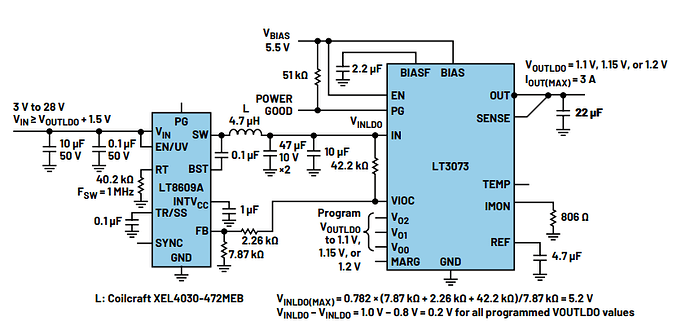VIOC (Voltage Input-Output Control) is a dynamic power management technology. Its core function is to enable an LDO (Low-Dropout Regulator) with VIOC capability to real-time adjust the output of the upstream step-down switching regulator, so as to keep the difference (dropout voltage) between the LDO’s input voltage and output voltage constant. This achieves a power supply system with low noise, high efficiency, and high reliability.
VIOC System: The “Cooperative Closed-Loop” Between LDO and Step-Down Switching Regulator
Take the ADI LT3073 as an example: VIOC is a built-in function of LDOs such as the LT3073. It adjusts the upstream switching regulator by outputting control signals, maintains a constant dropout voltage between the LDO’s input and output, and optimizes noise, PSRR (Power Supply Rejection Ratio), and power consumption.
Power Supply System of “Switching Regulator (Buck) + VIOC-Controlled Linear Regulator (LDO)” (Image source: ADI)
This is a two-stage power supply system consisting of a switching regulator (Buck) + VIOC-controlled linear regulator (LDO). It combines the high efficiency of the switching regulator with the low noise and high PSRR characteristics of the LDO, and is suitable for scenarios sensitive to power supply noise (such as radio frequency circuits, high-precision analog circuits, and power supply for high-performance processors). The modules are analyzed as follows:
1. Upstream: Synchronous Buck Converter (LT8609)
This is responsible for efficient step-down conversion, converting a wide-range input (3V~28V) into the input voltage of the LDO (VINLDO), while accepting the VIOC signal from the LDO to dynamically adjust its output.
Core Components and Pin Functions:
- Input Filtering: A 50μF capacitor is connected in parallel with V₍IN₎ to filter out ripples in the input power supply.
- Switching Node (SW): Connected to a 4.7μH inductor, which realizes step-down conversion through energy storage and discharge of the inductor.
- Bootstrap (BST): A 1μF capacitor is connected in series to provide the driving voltage for the gate of the high-side MOSFET inside the Buck converter.
- Feedback (FB): Connected to a voltage divider resistor (7.87kΩ + 2.26kΩ) and simultaneously receives the VIOC signal from the LDO to dynamically adjust the output voltage of the Buck converter.
- Frequency / Soft-Start (RT/SS): An external 0.1μF capacitor is connected to set the switching frequency (FSW = 1MHz) and soft-start time, avoiding start-up inrush current.
- Output Filtering: Capacitors (47μF × 2 + 10μF) are connected in parallel after the inductor to significantly suppress switching ripples and provide a “relatively clean” input voltage for the LDO.
2. Downstream: VIOC-Controlled LDO (LT3073)
This dynamically controls the output of the Buck converter through VIOC technology, maintains a constant dropout voltage between its own input (VINLDO) and output (VOUTLDO), and ultimately provides ultra-low noise and high PSRR power supply for the load.
Core Role of VIOC:
The LDO internally monitors the dropout voltage of “VINLDO - VOUTLDO” in real time, and outputs a voltage signal to the FB pin of the Buck converter through the VIOC pin, enabling the Buck converter to dynamically adjust its output. Finally, the dropout voltage of the LDO is stabilized within the optimal range (the annotation in the figure shows that the dropout voltage is approximately 0.2V~0.3V) — this not only prevents the LDO from malfunctioning due to excessively low dropout voltage, but also avoids a surge in power consumption/noise caused by excessively high dropout voltage.
Key Pins and Component Functions:
- VIOC: A control output pin directly connected to the FB of the Buck converter, serving as a dynamic control bridge from LDO to Buck.
- BIAS/BIASF: Bias power supply pins, with VBias = 5.5V. A 2.2μF capacitor is connected in parallel with BIASF for filtering, providing a stable bias for the internal circuits of the LDO (including the VIOC module).
- IN: The input pin of the LDO, which receives the output voltage of the Buck converter, and its voltage range is dynamically adjusted by VIOC.
- OUT/SENSE: Output and sampling pins. VOUTLDO can be programmed to 1.1V/1.15V/1.2V, and a 22μF capacitor is connected in parallel to further filter out noise and provide clean power for the load.
- REF: Reference voltage pin. A 4.7μF capacitor is connected in parallel to stabilize the internal reference voltage and enhance the output noise suppression capability.
- IMON: Current monitoring pin. An external 806Ω resistor is connected to convert the output current into a voltage signal (for current monitoring or overcurrent protection).
- MARG/PG/EN: Pins for margin adjustment (fine-tuning the output voltage), power-good indication (outputs a high level when the output is stable), and enable control (turning the LDO on/off).
Advantages and Application Scenarios of the VIOC System
Balance Between Efficiency and Noise:
The Buck converter is responsible for “rough step-down” to achieve high efficiency, the LDO is responsible for “precise voltage regulation” to achieve low noise, and VIOC dynamically optimizes the LDO’s dropout voltage to maximize the advantages of both.
Application Scenarios:
Fields sensitive to power supply noise, such as radio frequency (RF) transceivers, high-precision ADCs/DACs, FPGA/DSP core power supplies, and medical instruments.
In short, this is a two-stage power supply solution that achieves high efficiency + low noise through cooperative control via VIOC technology, balancing energy conversion efficiency and power supply purity.
Related part number:
- ADI LDO LT3073
- Development Board EVAL-LT3073-AZ
- ADI DC-DC Switching Regulator LT8609
Related Materials:
- LT3073 Data Sheet
More contents:
- ADI Linear Regulator LT3073 - What is VIOC (Voltage Input-Output Control)?
- ADI Linear Regulator LT3073 - What is “Output Type: Programmable”?
- ADI Linear Regulator LT3073 - How to Achieve High-Precision Current Monitoring?
- ADI Linear Regulator LT3073 - How to Implement a Fast Start-Up Circuit?
- ADI Linear Regulator LT3073 - How to Realize Multi-Device Parallel Connection?
- ADI Linear Regulator LT3073 - Pairing Combination of LDO with VIOC Function and Switching Regulator

